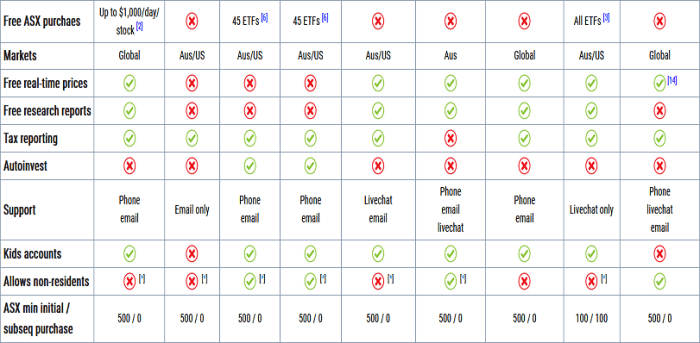Comparison of investment platforms sets the stage for this enthralling narrative, offering readers a glimpse into a story that is rich in detail with American high school hip style and brimming with originality from the outset.
As we delve into the world of investment platforms, we will explore the different types available, the variety of investment options they offer, the user interface and experience they provide, and the crucial aspects of customer support and security.
Types of Investment Platforms
Investment platforms come in various forms, catering to different investor preferences and needs. The two main types include traditional brokerage platforms and modern robo-advisors.
Traditional Brokerage Platforms
Traditional brokerage platforms are typically used by experienced investors who prefer a hands-on approach to managing their investments. These platforms offer a wide range of investment options, including stocks, bonds, mutual funds, and more. Investors have the freedom to make their own investment decisions and actively trade securities. Examples of traditional brokerage platforms include Charles Schwab and Fidelity Investments.
Modern Robo-Advisors
Robo-advisors are automated investment platforms that use algorithms and computer models to provide investment advice and manage portfolios. They are ideal for beginner investors or those who prefer a more hands-off approach to investing. Robo-advisors offer automatic rebalancing, tax-loss harvesting, and low fees compared to traditional brokerage platforms. Examples of popular robo-advisors include Betterment and Wealthfront.
Investment Options Offered
When it comes to investment platforms, there is a wide range of investment options available to investors. These options typically include stocks, bonds, ETFs (exchange-traded funds), mutual funds, and more. Each of these investment options comes with its own set of risks and potential returns, catering to different risk appetites of investors.
Types of Investment Options
- Stocks: Investing in individual company stocks allows investors to own a portion of the company and benefit from its growth.
- Bonds: Bonds are debt securities issued by governments or corporations, providing a fixed income stream to investors.
- ETFs: ETFs are investment funds that are traded on stock exchanges, offering diversification and lower costs compared to mutual funds.
- Mutual Funds: Mutual funds pool money from multiple investors to invest in a diversified portfolio of stocks, bonds, or other securities.
Risk Appetite and Investment Platforms
Different investment platforms cater to varying risk appetites of investors. Some platforms may focus on low-risk investments like government bonds, while others offer a range of options from conservative to aggressive investments. It’s essential for investors to choose a platform that aligns with their risk tolerance and investment goals.
Comparison of Fees
- Some investment platforms charge commission fees for buying and selling securities, while others offer commission-free trading.
- Management fees, also known as expense ratios, may apply to mutual funds and ETFs, impacting overall returns.
- Robo-advisors typically charge a management fee based on a percentage of assets under management.
User Interface and Experience
When it comes to investment platforms, the user interface plays a crucial role in shaping the overall user experience. A well-designed interface can make it easier for investors to navigate the platform, set up their accounts, and access educational resources. On the other hand, a poorly designed interface can lead to frustration and confusion among users.
Platform Navigation
- Platforms with intuitive navigation menus and clear labeling make it easy for users to find what they’re looking for quickly.
- Some platforms offer customizable dashboards that allow users to arrange information according to their preferences.
- Platforms with search functionality can help users locate specific features or resources efficiently.
Account Setup Process
- Platforms that offer a streamlined account setup process with clear instructions and minimal steps tend to attract more users.
- Some platforms offer guided account setup wizards to assist users in completing the process smoothly.
- Platforms that require excessive documentation or verification steps may discourage potential users from signing up.
Educational Resources
- Platforms that provide comprehensive educational resources, such as articles, tutorials, webinars, and demo accounts, can help users make informed investment decisions.
- Interactive tools like calculators, investment simulators, and risk assessment quizzes can enhance the learning experience for users.
- Access to a supportive community or forum where users can ask questions and share insights can also contribute to a positive user experience.
Mobile-Friendliness and Accessibility
- Investment platforms that offer mobile apps or responsive websites cater to users who prefer to manage their investments on the go.
- Platforms with mobile-friendly interfaces that adapt to different screen sizes and resolutions provide a seamless experience across devices.
- Accessibility features such as text-to-speech, screen reader compatibility, and high contrast modes can make platforms more inclusive for users with disabilities.
Customer Support and Security

Investing can be a daunting task, especially for beginners, so having reliable customer support and robust security measures in place is crucial for any investment platform. Let’s delve into how different platforms handle these aspects to ensure a smooth and secure investing experience.
Customer Support Services
- Live Chat: Some platforms offer live chat support, allowing users to get immediate assistance for their queries or concerns.
- Phone Support: Having a phone support option can be beneficial for users who prefer speaking directly to a customer service representative.
- Email Support: Most platforms provide email support for users to reach out with their questions or issues, with responses typically within a specified timeframe.
Security Measures
- Encryption: Platforms often use encryption technology to secure users’ data and financial information from unauthorized access.
- Two-Factor Authentication: Implementing two-factor authentication adds an extra layer of security by requiring users to provide two forms of verification to access their accounts.
- Regulatory Compliance: Platforms that comply with industry regulations and standards are more likely to have robust security measures in place to protect investors.
